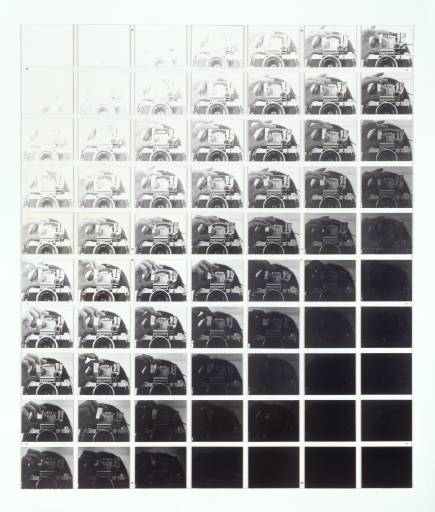Prototyping 18 Feb 2013: Difference between revisions
No edit summary |
No edit summary |
||
| Line 1: | Line 1: | ||
== A Camera Recording Its Own Condition == | |||
[[File:John-Hilliard-Camera-Recording-its-Own-Condition-1971.jpg|frame|[[wikipedia:John Hilliard (artist)|John Hilliard]]'s <em>A Camera Recording Its Own Condition (7 aperatures, 10 speeds, 2 mirrors)</em>, 1971]] | [[File:John-Hilliard-Camera-Recording-its-Own-Condition-1971.jpg|frame|[[wikipedia:John Hilliard (artist)|John Hilliard]]'s <em>A Camera Recording Its Own Condition (7 aperatures, 10 speeds, 2 mirrors)</em>, 1971]] | ||
Revision as of 11:38, 19 February 2013
A Camera Recording Its Own Condition

John Hilliard's A Camera Recording Its Own Condition, is a central example in Matthew Fuller's Media Ecologies (forming the basis of a chapter entitled "The Camera That Ate Itself". Here Fuller describes the work:
A camera is positioned in front of a mirror. The photographer works through every combination of settings for aperture and speed. Each time the combination of settings is changed, a picture is taken. The hands working the smaller mirror, showing the settings on the top of the apparatus. At tthe upper left of the grid of prints resulting from this program of work, the emulsion is left utterly unstained. From the bottom right corner, up to a diagonal margin, and encompassing almost a third of the prints, the results are completely black.
Every size of aperture allowed by the camera is run through, correlated with a a procedural workout of every shutter speed. As the various combinations are made, the two mirrors bounce the camera's own reflected light back to it and the film it contains is reorganized by a measured amount of exposure to light waves. The seventy negatives resulting from this procedure allow, through the prints derived from their transition from whiteness to blackness, the gradually appearing and disappearing image of the camera to be seen. The program of the image is both built and erasued by the apparatus that composes it. In "photography," the proper use of a camera, the degree of darkness or lightness of the image, indicates the closeness to or distance from sources of diffuse or direct light of the object being photographed. Such use of the apparatus is here revealed as being precariously lodged between whiteout and blackout.[1]
Pipelines vs. Seamlessness
In part of their discussion of webcam sites in the book Remediation, Bolter and Grusin suggest that "the ultimate ambition of the Web designer seems to be to integrate and absorb all other media." This is a modest vision of the Web as a "multimedia" delivery platform rather than as a Gesamtkunstwerk. Gesamtkunstwerk as a climactic realization of Romantic holism becomes subordinate to the cross-media leveraging and confluence of "intellectual properties." It is immediately problematized, though (in terms that are usefully susceptible to a consideration via memtic "fidelity"), by a variant on a primal problematic in media - that media have their own terms of composition. Cite error: Closing
</ref>missing for<ref>tag
References
- ↑ Matthew Fuller, Media Ecologies, 2005, p. 58
